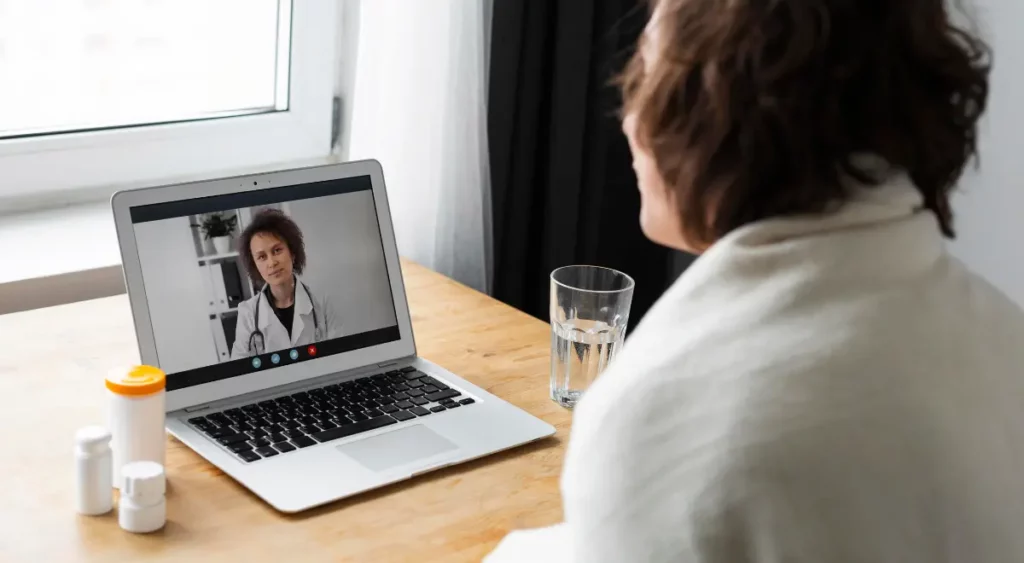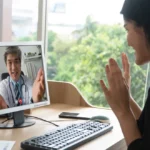What is Care Coordination & Its Importance in Remote Healthcare?

Care coordination connects patients, providers, and caregivers through seamless communication and shared data. In remote healthcare, it ensures timely interventions, reduces hospitalizations, and improves patient outcomes while cutting administrative burden.
As per the Centers for Disease Control and Prevention (CDC), the global Remote Patient Monitoring (RPM) market is estimated to grow from $27.72 in 2024 to over $53.6 billion in 2030, with an increase in chronic conditions, an aging population, and value-based care demand acting as key growth drivers.
Around 60 percent of adults in the US suffer from at least one chronic disease, usually requiring treatment from more than one provider across different care settings. Lack of care coordination disturbs the care delivery model; fragments care plans, and delays interventions that could have prevented hospitalizations, while ensuring the health of patients.
Care coordination lays the foundation to keep all care providers, caregivers, and patients in real-time alignment, especially where the delivery of care of patients is via remote healthcare. It creates pathways from disconnected services to a seamless patient experience.
Table of Contents
ToggleWhat is Care Coordination in Remote Healthcare?
In simpler terms, care coordination is about ensuring all care management staff work from the same playbook to deliver unified patient care. It refers to the organization and integration of patient care plans between multiple healthcare providers and services backed by digital tools. The main focus of care coordination is to maintain continuity, consistency, and engagement.
This means:
- Centralizing patient data from RPM devices, EHRs, and labs;
- Ensuring care team members have real-time communication between them;
- Giving patients the power to understand and participate in the care plan;
- Automating monitoring, alerts, and follow-ups
- Aligning everybody from primary care specialists to patients for the expected outcomes
Why Care Coordination is Important in Remote Healthcare
- Reduces Fragmentation and Miscommunication: Issues like duplication of tests, conflicting treatments, neglect of referrals, and confusion amongst patients arise due to lack of coordination in traditional in-person care models.
- Without coordination, providers work in isolation
- With coordination, everyone shares unified patient insights
- Patients get the same instructions and messages
- Improves Health Outcomes and Reduces Hospitalizations: In remote patient care industry, where patients are being monitored and managed remotely, it is possible that when an emergency event or situation arises, it can be handled at the onset before it results in ER or hospital admissions. Researches show that care coordination can:
- Reduce hospital readmissions by 30%
- Reduce the overall cost of healthcare by 22-25%
- Enhance medication adherence and treatment compliance
A clinical intervention at an early stage is far less costly and more effective.
- Builds Efficiency into Provider Operations: Care coordination creates streamlined workflows that simplify documentation, automate alerts, and centralize patient data. This frees up clinicians so they can provide for the tasks which require their clinical attention and care.
This also allows for better transition of care from one provider to another, fewer delays in care, and fewer administrative errors. For instance, automated alerts for elevated blood pressure readings allow clinical staff to promptly intervene, preventing unnecessary ER visits.
- Patient Empowerment and Building Trust: Patients who see clear communication amongst their care staff often report feeling more secure, empowered, and actively engaged in their health journeys. This leads to:
- Higher patient satisfaction rate
- Increased patient engagement and self-management
- Higher adherence to lifestyle changes or medications
Trust in remote care comes from transparency and consistency, both being outcomes of good coordination.
Core Components of Remote Care Coordination
- Centralized Health Data: Key to care coordination is unified, real-time health data. Cellular medical devices such as blood pressure monitors, glucose monitors, and pulse oximeters send their data into a centralized system. When this data is combined with the data reported from EHRs, lab results, or medication records, it gives providers a holistic view of the patient’s health. They in turn use this data to make decisions, issue alerts, and modify care plans.
- Collaborative and Dynamic Care Plans: Care coordination platforms enable care planning by multiple healthcare providers. For instance, a patient’s primary care doctor, cardiologist, or care manager can contribute to or view a care plan in real-time. The care plan should be:
- Customized according to patients’ conditions, goals, and preferences.
- Modified as the conditions change or as patient vitals vary.
- Open and accessible for each stakeholder in the care delivery model.
For example, when a patient’s glucose levels spike, the care team instantly reviews real-time data, adjusting medications or scheduling virtual check-ins promptly.
- Automated Alerts and Monitoring: Automated alerts not only detect deviations early but ensure rapid and targeted intervention, significantly reducing risk and patient complications. Alerts may be sent out to the care team members for increasing blood pressure or decreasing oxygen saturation levels. This allows speedy intervention and prevents complications.
An automatic alert system ensures that the right provider is alerted at the right time with the right patient data.
- Patient Engagement and Education: Patients are no longer passive recipients of care, they are participants. Through patient portals and mobile applications, they can:
- Monitor their own metrics
- Message their care team
- View upcoming appointments and care plans
- Receive health education tailored for them
When patients are engaged, they always comply with treatment plans and stay engaged in their own care. For instance, diabetic patients can track blood sugar trends, receive timely reminders for medication, and reach their care team instantly if they notice unusual symptoms.
The Future of Care Coordination in Remote Health Industry
As health systems decentralize, care coordination will become much more important. Looking ahead, care coordination will increasingly integrate predictive analytics, artificial intelligence, and interoperability standards, facilitating personalized, proactive patient care. Some modern technologies that focus on care coordination include:
Remote Patient Monitoring (RPM): RPM technology captures and analyzes daily vitals, while also integrating its data with larger systems that allow for care coordination. RPM is the primary data engine driving modern day remote care.
Electronic Health Records (EHRs): The historical context around the patient, their medications, allergies, and diagnosis gives RPM a complete outlook of the patient information after integration with a unified platform.
Interoperability Standards (FHIR, HL7): These data frameworks allow health systems to communicate with each other. Without interoperability, the care delivery model may get stuck in a silo.
Artificial Intelligence/ Predictive Analytics: AI can flag patients that are at risk of exacerbation, project their complications based on trends, and optimize workflows to get better quality outcomes with minimal efforts.
Mobile Applications, Portals & Referrals: Intuitive for patients, mobile applications allow for easy data access, patient reminders, and ease of communication with the care team.
The coordinated care framework ensures that wherever the patient is located, they receive the same care, attention, accountability, and compassion as they would in a clinical environment.
Key Takeaways
- Care coordination links providers, patients, and caregivers.
- It reduces duplication of tests and medical errors.
- Remote healthcare tools make coordination more efficient.
- Strong coordination improves outcomes and lowers costs.
- Technology-driven care coordination supports value-based care.
Conclusion
HealthArc’s care coordination platform empowers clinicians to accelerate better health decisions that lead to a higher quality of care. From on-demand urgent care to support for chronic and complex health challenges, we’re changing the way clinicians and patients access remote healthcare, from the comfort of their homes.
Frequently Asked Questions (FAQs)
Care coordination is pulling together everyone who helps with a patient’s care—doctors, nurses, families, and the patient—so that the right care happens smoothly and arrives on time.
In telehealth and remote care, the online links keep treatments together, making sure nurses call on the right day, doctors read the same notes, and families know when to remind a patient to take a dose.
It keeps patients moving safely between hospitals and homes, helps them master their treatment, and lumps together complex steps that could trip them up.
Mobile apps, secure messages, and readouts from smart scales provide the patient’s team with up-to-date information, eliminating delays and uncertainty.
When the team charts a plan everyone takes seriously, the same test isn’t run again, missteps are caught early, and rehospitalizations become a rare exception, not a rule.
All types of providers—doctors, nurses, health coaches, and specialists—work together to keep a patient’s steps clear and follow them.
Absolutely. When remote patient monitoring and chronic care management go hand in hand, everyone in the care team reads, replies, and checks the next steps the same way.
Value-based healthcare counts on lower costs, satisfied patients, and better all-round results, and care coordination delivers all three with one smart plan.
Interested in changing your remote care strategy? HealthArc’s care coordination platform makes care coordination simple and impactful, combining RPM and automated alerts with collaboration tools, all into one simple solution. Schedule a demo today and see how we redefine remote health care together.
Most Recent Blogs
Categories
Related Blog
- December 15, 2025 | Read Time: 10 mins
G2211 CPT Code: Complete Description, Billing Guidelines & Reimbursement
G2211 CPT code is an add-on HCPCS code that lets you capture...
Learn More- December 11, 2025 | Read Time: 11 mins
2026 Medicare Annual Wellness Visit CPT Codes: G0402, G0438, G0439
Medicare uses three main HCPCS codes for 2026 Annual Wellness Visits (AWVs):...
Learn More- September 4, 2025 | Read Time: 11 mins
How CMS 2026 Medicare Proposed Rules will affect Telehealth & RPM
The CMS 2026 Medicare Physician Fee Schedule proposed rule could be the...
Learn More


